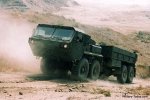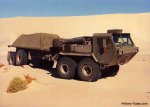Warren Lovell
Member
- 476
- 4
- 18
- Location
- SAN DIEGO, CA
The Oshkosh Mk.48 series of articulated trucks began life as the Lockheed design, named 'Twister'. Later the Oshkosh Truck Corporation signed license agreement with Lockheed and developed it into commercial design. In 1983 it was ordered by the US Marine Corps as the Mk.48 LVS (Logistic Vehicle System). Sometimes it is nicknamed the Dragon Wagon. This nickname was borrowed from the World War II tank transporter. A total of 1433 Mk.48 vehicles were ordered. Deliveries commenced in 1985.
The Oshlosh LVS was a mainstay of the USMC logistics fleet. This 8x8 tactical truck is used to transport heavy equipment and basic supplies, such as ammunition, fuel and water. The LVS has a payload capacity of 12.5 t off road and 22.5 t on hard surface roads. It can also tow a trailer.
All models of the Dragon Wagon share the same articulated joint feature. It is located behind the front pair of axles and divides vehicle into front and rear modules. There is a degree of independent movement between the front and rear units for more mobility. In theory, the front module could be used with any of the other rear modules.
The common front module consists of a cab, engine and transmission. Cab provides seating for driver and co-driver. There is also space for crew stowage. The rear modules differ by function.
The Oshkosh Mk.48 LVS is powered by a Detroit Diesel 8V92TA turbocharged diesel engine, developing 450 hp. Vehicle is fitted with a central tyre inflation system and has an excellent off-road mobility, even with full load. A self-recovery winch was standard across the range.
The LVS also steers through both standard wheel pivoting (as on a typical automobile) and hydraulic yaw steering (by articulating the Front Power Unit against the Rear Body Unit). This gives the LVS remarkable maneuverability for its size.
The United States Army has a similar tactical vehicle called the Heavy Expanded Mobility Tactical Truck (HEMTT). The key differences between the two is the LVS's ability to interchange Front Power Units with Rear Body Units.
In 2006 the US Marine Corps selected the new Oshkosh LVSR (Logistic Vehicle System Replacement). It is a 10x10 vehicle, fitted with an armored cab.
Mk.48/14 a flatbed truck, equipped to carry standard logistics containers
Mk. 48/15 recovery vehicle, fitted with a hydraulic crane and recovery winch
Mk. 48/16 tractor truck with shorter wheelbase, capable of pulling tank transporter semi-trailers
Mk. 48/17 cargo carrier with a hydraulic load handling crane. It is capable of carrying loads up to 18000 kg on hard surface roads
Mk. 48/18 self loading container and bridge transporter.
The LVS is composed of a Front Power Unit (FPU) coupled to a Rear Body Unit (RBU). The FPU can be driven on its own, but is front-heavy in this mode and prone to nose-diving when the brakes are applied. A suspension lockout strut reduces this problem. When describing a truck it is remarked by the combination of both units, for example, an MK48 FPU attached to an MK18 RBU is called a "48/18". For MK16's, which tow M870 semi-trailers, the type of trailer is added as well, i.e. "48/16/870A2".
The Oshlosh LVS was a mainstay of the USMC logistics fleet. This 8x8 tactical truck is used to transport heavy equipment and basic supplies, such as ammunition, fuel and water. The LVS has a payload capacity of 12.5 t off road and 22.5 t on hard surface roads. It can also tow a trailer.
All models of the Dragon Wagon share the same articulated joint feature. It is located behind the front pair of axles and divides vehicle into front and rear modules. There is a degree of independent movement between the front and rear units for more mobility. In theory, the front module could be used with any of the other rear modules.
The common front module consists of a cab, engine and transmission. Cab provides seating for driver and co-driver. There is also space for crew stowage. The rear modules differ by function.
The Oshkosh Mk.48 LVS is powered by a Detroit Diesel 8V92TA turbocharged diesel engine, developing 450 hp. Vehicle is fitted with a central tyre inflation system and has an excellent off-road mobility, even with full load. A self-recovery winch was standard across the range.
The LVS also steers through both standard wheel pivoting (as on a typical automobile) and hydraulic yaw steering (by articulating the Front Power Unit against the Rear Body Unit). This gives the LVS remarkable maneuverability for its size.
The United States Army has a similar tactical vehicle called the Heavy Expanded Mobility Tactical Truck (HEMTT). The key differences between the two is the LVS's ability to interchange Front Power Units with Rear Body Units.
In 2006 the US Marine Corps selected the new Oshkosh LVSR (Logistic Vehicle System Replacement). It is a 10x10 vehicle, fitted with an armored cab.
VARIANTS
Mk.48/14 a flatbed truck, equipped to carry standard logistics containers
Mk. 48/15 recovery vehicle, fitted with a hydraulic crane and recovery winch
Mk. 48/16 tractor truck with shorter wheelbase, capable of pulling tank transporter semi-trailers
Mk. 48/17 cargo carrier with a hydraulic load handling crane. It is capable of carrying loads up to 18000 kg on hard surface roads
Mk. 48/18 self loading container and bridge transporter.
The LVS is composed of a Front Power Unit (FPU) coupled to a Rear Body Unit (RBU). The FPU can be driven on its own, but is front-heavy in this mode and prone to nose-diving when the brakes are applied. A suspension lockout strut reduces this problem. When describing a truck it is remarked by the combination of both units, for example, an MK48 FPU attached to an MK18 RBU is called a "48/18". For MK16's, which tow M870 semi-trailers, the type of trailer is added as well, i.e. "48/16/870A2".
DIMENSIONS AND WEIGHT
CURB WEIGHT: 18.3 - 22.9 TONS
MX LOAD: 12.5 TONS
LENGTH: 10.1-11.6 METERS
WIDTH: 2.44 METERS
HEIGHT: 2.59 METERS
MAXIMUM ROAD SPEED: 56.54 MPH
RANGE: 298.26 MILES
CAB SEATING: 1 + 1 MEN
CONFIGURATION: 8 x 8
MX LOAD: 12.5 TONS
LENGTH: 10.1-11.6 METERS
WIDTH: 2.44 METERS
HEIGHT: 2.59 METERS
MAXIMUM ROAD SPEED: 56.54 MPH
RANGE: 298.26 MILES
CAB SEATING: 1 + 1 MEN
CONFIGURATION: 8 x 8
Attachments
-
46.3 KB Views: 158
-
36.6 KB Views: 190




